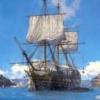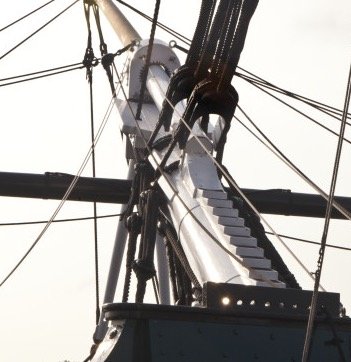-
Posts
513 -
Joined
-
Last visited
Content Type
Profiles
Forums
Gallery
Events
Posts posted by piratepete007
-
-
-
Thanks for that tip Greg. The Consitution seems to have gone through a number of refits, slowly returning to its 1812 form. The steps shown in the attached image of the Constitution bowsprit certainly show a bit of a 'staircase'. What I have seen are just strips of timber fixed along the bowsprit and I am trying to find out some more info on how common these were.
Pete
-
-
I often use household ammonia cleaner (dilute stuff) - relatively narrow PVC pipe; supported in a vertical position; bottom end sealed and capped. Strips of timber inserted into the tube, filled with the ammonia, cap placed over the top end, no troublesome odour. Left for approx. 5- 7 days (if not in a hurry, I aim for 2 weeks) and it works wonders. No problem at all and it DOES work.
Pete
-
I have another question to ask of the Forum. Looking at two 18C East Indiamen ships - the English Falmouth (some very early drawings) and the Swedish Goethenburg (video of the replica) and both ships have 'steps' running along the top edge of the bowsprit. The latter showed a sailor using these 'steps' as he moved up the mast. Can anybody shed any light on these ? Were they characteristic of a certain time period ? Were they only used on merchant vessels ? Only certain nations ? I am intrigued by this as today was the first time I became aware of such a bowsprit addition. Would like to get some more detail on these 'steps' for sure. I am aware that certain vessels also used a climbing rope up the bowsprit.
Pete
-
-
Thanks for your best wishes Pat. That style vanished from printing around 1780 - the 'f" being simply an elongated version of the handwriting style for 's' but did not have the traditional cross-bar. The 'f' was used at the start of a word or within a word but never at the end of a word. So the word compass would have been written as 'compafs'.
Thanks Pat and Henry for your replies.
Pete
-
Pat - yes I am but that is slow going as I am writing construction manuals as well. I just find it intriguing that we all build ships but do not necessarily know a great deal about some of the individual parts of a ship. That's the burden I carry having been an academic in the field of chemistry. In my previous post, why did the letter 'f' suffice for the letter 's' ? Guess I need to research that as well.
Pete
-
Look forward to it Vince. Rigging always slows down the visual progress but does not deter the satisfaction.
Pete
-
- BANYAN, keelhauled and mtaylor
-
 3
3
-
Danny,
Thanks for replying so quickly. The links you provided show the harpins (and ribbands) in their important role of temporarily holding the frames in position. My understanding is that after planking the exterior of the frames, these are removed. However, I found a reference to the harpins also in the role of being part of the wale as it curved around the bow and hence a permanent structure.
Pete
-
I need some help with a term - harpin -- that I came across and it is now annoying me that I can find very little about it. It is stuck in my mind and won't go away ! References are made to its temporary use to support cant frames during construction and I understand that use. But also, Steel and Mungo both make reference to it as that part of the wale that curves around the bow. In this form, it is thicker than the wale and gives extra support to that part of the ship which is subject to additional stress in rough seas. If it is a continuance of the wale, then how far aft does it extend ? No matter how I search, there are no diagrams/ drawings to be found. Is the harpin considered a component piece of the ALL wales or just one or two ?
I would really appreciate anybody giving me/ us a clear description of this piece and maybe locate a drawing as well.
Pete
-
All the best Ken for next Thursday. Will miss your regular updates but wishing you a speedy recovery so you can continue with your build and our entertainment.
Pete
- ken3335 and marktiedens
-
 2
2
-
Without getting carried away with too many accolades to the various builders - who are doing some phenomenal work - of the RW (Royal William), I have been working quietly in the background adding parts of their various posts into my own work. This requires considerable editing but above all it has forced me to look at my own work and update that as well. So ... at the end of each month, I plan to have an update placed on the Euromodel website for this ship that will encompass everybody's work (like ... RW.04.HULL CONSTR.May 2017). At the risk of being repetitive, these notes/ files are only being written for others to freely use and that is my ONLY payment. So, thanks guys for allowing me to use your work - its just great fun to do !
Pete
- ken3335, BillLib, marktiedens and 2 others
-
 5
5
-
Ken - its just getting better and better. Congrats to you on keeping an open mind and coming up with your own concept.
Pete
- marktiedens, WackoWolf, ken3335 and 1 other
-
 4
4
-
I might also add that its been fantastic to see a couple of little techniques used by two Royal William builders - Mark (eye bolts) and Ken ('tracing' a portion of a drawing onto the ship's side) being posted in the last day or so. That is the sort of thing that adds a little icing to the cake. Please keep posting these little gems so we can all be inspired.
Pete
- coxswain and marktiedens
-
 2
2
-
Mark, your illustration of making eyebolts is a great example of improvisation and just 'getting on with it'. Simple and to the point.
Pete
-
Mark, you have 'mastered' this area of your ship-building so well. Congrats.
Nautical terms are funny at times - those knobs on the top end of the masts are termed 'trucks' .... and yet the wheels on the gun carriages are also termed 'trucks' ! I hope I have got that correct.
Pete
- coxswain and marktiedens
-
 2
2
-
-
-
Ken,
Yes, Pete is smiling ... and in a happy way. You have finally been caught by the philosophy behind the Euromodel builds which is designed to encourage you to grab a succession of opportunities, explore different techniques and to make changes as you see fit. I agree whole heartedly with your comments re the windows and look forward to seeing the final outcome. A long task but a worthwhile one.
Pete
- ken3335, Hubac's Historian and pirozzi
-
 3
3
-
David Steel (1794, 234) describes these chains and rope pendants in some detail and it is quite an experience to dissect out each component part of his commentary. Mark has gone to the trouble of adding chains where none were shown but albeit kept it as a simplified version. Plan drawings are useful but when some detailed research is carried out, it is surprising to grasp the full complexity of naval rigging. Great to see that both Mark and Vince have made some changes in this area.
Pete
-
What is more remarkable is that this Confederate ship was built in secrecy in England in 1862 where a loophole in the English Neutrality Act allowed an 'armed' ship to be built as long as it carried no armament - even if it had reinforced decks, etc. This ship was sailed to the Azores where it was fully equipped as an armed vessel. The history of this vessel makes for fascinating reading ..... have a look on the Internet.
Pete
-




.png.4fc6e6fe3cb18a0710027a09a4241821.png)
Royal William by marktiedens - FINISHED - Euromodel - scale 1:72
in - Kit build logs for subjects built from 1501 - 1750
Posted
Whow Mark - that IS fiddly work as you say. Looks really fantastic in its workmanship and detail. The addition of catharpins would be a very interesting touch.
What is the stave CS dimension ?
Pete